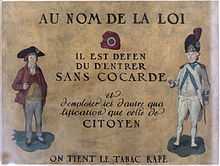Marouflage
Marouflage is a technique for affixing a painted canvas to a wall to be used as a mural, using an adhesive that hardens as it dries such as plaster or cement.
History

A French word originally referring to sticky, partly hardened scraps of paint, marouflage is a 3,000-year-old technique. Historically, artists used several types of adhesives including a rabbit-skin glue. White lead ore was used in the 19th and 20th centuries in the mixture to help it dry.
A thin coat of the adhesive is applied to both the wall and the canvas. Once the canvas is mounted to the wall, pressure is exerted with rubber hand rollers to smooth the canvas and remove any bubbles.
Uses
Conservation
In art conservation, the word is a term of art meaning the removal of the painted surface from its underlying support, usually a stretched canvas. The process flattens the impasto of a painting and is, therefore, probably the most extreme form of intervention that a painting can suffer. It should be used as a last resort because of the intrinsic damage that the process itself causes. Paintings that have been marouflaged include the Louvre's version of the Madonna of the Rocks and many of Turner's canvasses in the care of the Tate Gallery.
Murals
Intended murals are normally painted on large canvas in the studio and attached to the wall on site, using a starch based glue (applied to the wall only), the murals can then be moved (by a professional) and re-instated elsewhere if required. The damage caused to the painting if removed using this technique is minimal.
References
| Wikimedia Commons has media related to Marouflage. |
- Mayer, Ralph. The Artist's Handbook of Materials and Techniques Viking Adult; 5th revised and updated edition, 1991. ISBN 0-670-83701-6